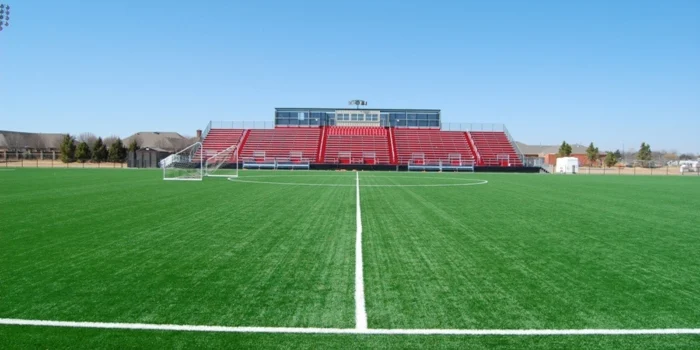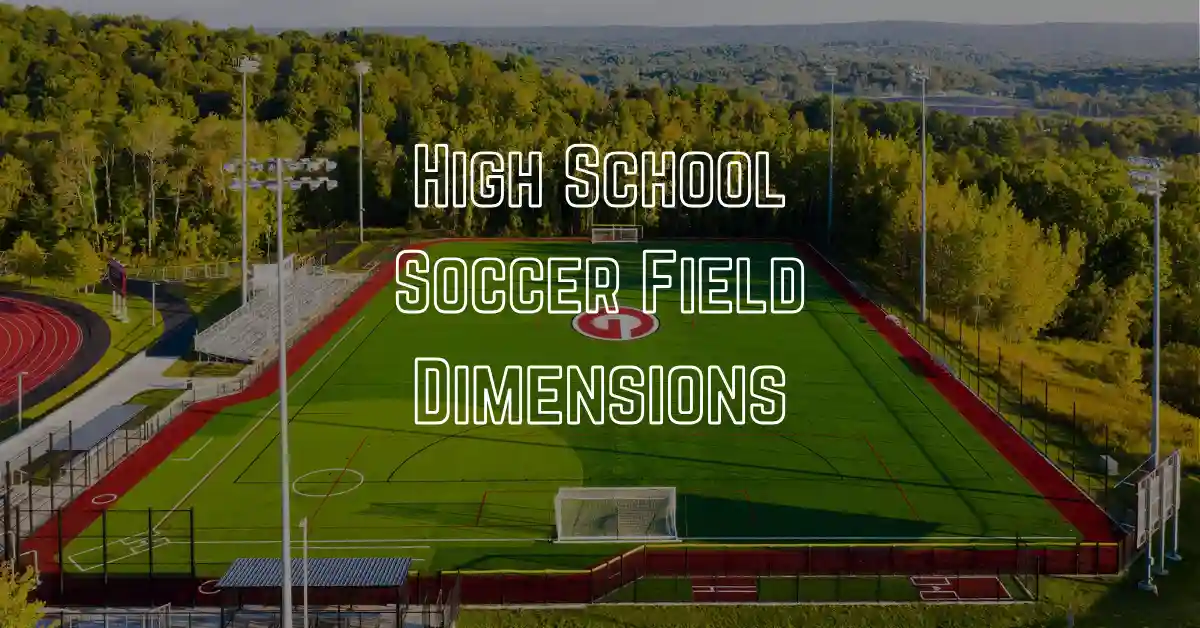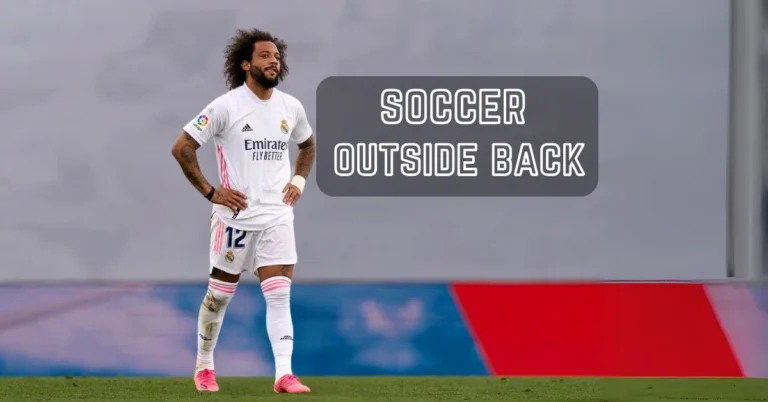High School Soccer Field Dimensions – Comparison With Other Fields
Soccer, a sport that unites nations and communities, relies heavily on the dimensions of its playing field. Understanding specific dimensions of high school soccer is crucial for fair play and player development. Compared to professional soccer fields, high school soccer fields are smaller.

A high school soccer field is usually 20 yards shorter and 15 yards narrower than a professional soccer field due to space constraints.
dimensions of a high school soccer field?

According to FIFA, the typical high school soccer field dimensions are approximately 100-120 yards in length and 55-80 yards in width.
| Area of the Field | Measurements |
|---|---|
| Length of the field | 100 – 120 yards (90 – 110 meters) |
| Width of the field | 55 – 80 yards (50 – 73 meters) |
| Goal area depth | 6 yards (5.5 m) |
| Goal area width | 20 yards (18.3 m) |
| Penalty area depth | 18 yards (16.5 m) |
| Penalty area width | 44 yards (40.3 m) |
| Goal width | 8 yards (7.32 m) |
Here is a complete measurement of all areas of the high school soccer field:
field Length
The distance between the ends of a high school soccer field is its length. Soccer length is measured along the touchlines or sidelines. The recommended length for a high school soccer field is 100–120 yards (90–110 meters).
field width
The width of a high school soccer field is measured from side to side. Soccer width is measured along goal lines. A high school soccer pitch should be 55 to 80 yards wide, or 50 to 73 meters.
center circle
The center circle on a high school soccer field is a marked circular area located at the midpoint of the field. This circle has specific dimensions and serves various purposes during a soccer match. The diameter of the center circle can vary, but it is commonly around 10 yards (30 feet) in diameter.
center spot
The center spot on a high school soccer field is a marked point located at the exact center of the field. It is a critical element of the field, often coinciding with the center of the center circle. The center spot itself is usually a small, marked circle on the field, typically with a diameter of 9 inches.
Goal depth
The goal depth in high school soccer refers to the distance between the goalposts, which are the two vertical posts that support the crossbar, and it extends backward from the goal line. The standard goal depth for high school soccer is typically 6 yards (5.5 meters).
Goal width
The goal width in high school soccer refers to the distance between the inside edges of the two goalposts. The standard goal width for high school soccer is typically 20 yards ( 18.3 meters).
Penalty area depth
The penalty area depth in high school soccer refers to the distance from the goal line to the outer edge of the penalty area. The standard depth of the penalty area for high school soccer is typically 18 yards (54 feet or approximately 16.46 meters).
Penalty area width
The penalty area width in high school soccer refers to the distance between the two parallel lines that form the sides of the penalty area. The standard width of the penalty area for high school soccer is typically 44 yards (132 feet or approximately 40.23 meters).
Goal width
The goal width in high school soccer, as per standard regulations, is 8 yards. This measurement is equivalent to 24 feet or approximately 7.32 meters. The goal width is the distance between the inside edges of the two goalposts.
Goal line to penalty spot
The distance from the goal line to the penalty spot in high school soccer is typically 12 yards. This measurement is equivalent to 36 feet or approximately 10.97 meters. The penalty spot is a crucial element on the field, particularly for penalty kicks.
See Also: Maradona Soccer Move
Dimensions of the professional soccer field

A professional soccer field’s dimensions must be between 100 to 130 yards (90 to 120 meters) long and 50 to 100 yards (45 to 90 meters) broad, according to FIFA.
| Area of the Field | Goal-line to the penalty spot |
|---|---|
| Length of the field | 100 – 130 yards (90–120 meters) |
| Width of the field | 50 – 100 yards (45–90 meters) |
| Goal area depth | 6 yards (5.5 m) |
| Goal area width | 20 yards (18.3 m) |
| Penalty area depth | 18 yards (16.5 m) |
| Penalty area width | 44 yards (40.3 m) |
| Goal width | 8 yards (7.32 m) |
Here is a complete measurement of all areas of the professional soccer field:
Field Length
The length of a professional soccer field is typically in the range of 100 to 110 yards. This is equivalent to 300 to 330 feet or approximately 91 to 100 meters.
Field Width
The width of a professional soccer field is generally in the range of 50 to 100 yards. This is equivalent to 150 to 300 feet or approximately 45 to 91 meters.
Center Circle
Radius: 9.15 meters (30 feet) from the center of the circle, demarcated for restarts and kick-offs.
Center Spot
Diameter: 0.18 meters (7 inches), indicating the precise point for kick-offs at the center of the field.
Goal Area Depth
Extending 6 yards (5.5 meters)from the goal line, it defines the region where goal kicks are taken.
Goal Area Width
Extending 20 yards (18.3 meters) into the pitch, this area is crucial for goal kicks.
Penalty Area Depth
Extending 16.5 meters (18 yards) from the goal line, it is a critical zone for various penalties, including goal kicks and penalty kicks.
Penalty Area Width
Extending 40.3 meters ( 44 yards) on either side of the goalposts and 16.5 meters (18 yards) into the pitch, this area encompasses significant penalty-related actions.
Goal Width
The standard goal width is 7.32 meters (24 feet), providing a consistent measure for scoring objectives.
Goal-Line to the Penalty Spot
The distance from the goal line to the penalty spot is 11 meters (12 yards), determining the placement of penalty kicks.
See Also: Soccer Fun Facts
difference between high school and professional soccer field dimensions

This table gives us the difference between the dimensions of the high school soccer field and the professional soccer field.
| Area of the Field | High School Soccer Field Dimensions | Professional Soccer Field Dimensions |
|---|---|---|
| Length of the field | 100 – 120 yards (90 – 110 meters) | 100 – 130 yards (90-120 meters) |
| Width of the field | 55 – 80 yards (50 – 73 meters) | 50 – 100 yards (45–90 meters) |
| Center circle | 10 yards (radius) (9.15 m) | 10 yards (radius) (9.15 m) |
| Center spot | 9 inches (23 cm) | 9 inches (23 cm) |
| Goal area depth | 6 yards (5.5 m) | 6 yards (5.5 m) |
| Goal area width | 20 yards (18.3 m) | 20 yards (18.3 m) |
| Penalty area depth | 18 yards (16.5 m) | 18 yards (16.5 m) |
| Penalty area width | 44 yards (40.3 m) | 44 yards (40.3 m) |
| Goal width | 8 yards (7.32 m) | 8 yards (7.32 m) |
| Goal-line to penalty spot | 12 yards (11 m) | 12 yards (11 m) |
dimensions of the international soccer field

The dimensions of an international standard soccer field, as defined by FIFA (Fédération Internationale de Football Association), are as follows:
- Length of the field: Minimum 100 yards (100-110 meters), Maximum 130 yards (100-110 meters)
- Width of the field: Minimum 50 yards (50-100 meters), Maximum 100 yards (50-100 meters)
See Also: Sweeper Keeper
Why a High School Soccer Field Is Smaller Than a Professional Soccer Field

Here are some reasons why a high school soccer field is smaller than a professional soccer field:
- High school soccer fields are smaller due to limited space.
- Budget constraints influence the choice of field size.
- Smaller fields suit the developmental nature of high school soccer.
- They allow for more frequent ball interactions, enhancing player skills.
- Safety is a concern, and smaller fields reduce collision risks.
- Regulatory standards also dictate dimensions for high school fields.
- Professional fields accommodate top-level play and larger stadiums.
- The size difference aligns with the distinct needs and contexts of each level of play.
FAQs
The size of a high school football field can vary, but it typically falls within the range of 100 to 120 yards in length and 50 to 80 yards in width, meeting general football field standards.
An 11 vs 11 soccer field generally adheres to FIFA standards, with dimensions of a minimum of 100 yards and a maximum of 130 yards in length, and a minimum of 50 yards and a maximum of 100 yards in width.
No, soccer fields are not all the same dimensions. While there are standard dimensions outlined by organizations like FIFA, there can be variations in the size of soccer fields at different levels of play, such as local leagues or recreational fields.
FIFA specifies that an international soccer field should have dimensions between a minimum of 100 yards and a maximum of 130 yards in length, and a minimum of 50 yards and a maximum of 100 yards in width.
conclusion
High school soccer field dimensions are integral to the sport’s essence. Understanding and respecting these dimensions contribute to fair play, skill development, and an enriching soccer experience for all involved. As players, coaches, and administrators, let’s commit to upholding the standards set for soccer field dimensions.







